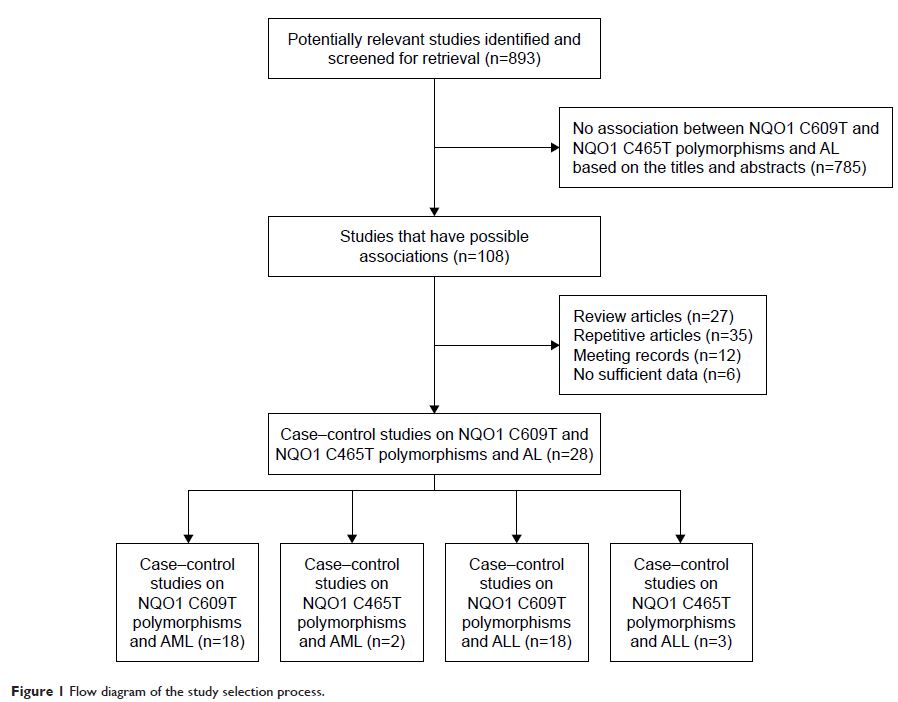9 7 2 2 7
论文已发表
注册即可获取德孚的最新动态
IF 收录期刊
- 3.3 Breast Cancer (Dove Med Press)
- 3.4 Clin Epidemiol
- 2.5 Cancer Manag Res
- 2.9 Infect Drug Resist
- 3.5 Clin Interv Aging
- 4.7 Drug Des Dev Ther
- 2.7 Int J Chronic Obstr
- 6.6 Int J Nanomed
- 2.5 Int J Women's Health
- 2.5 Neuropsych Dis Treat
- 2.7 OncoTargets Ther
- 2.0 Patient Prefer Adher
- 2.3 Ther Clin Risk Manag
- 2.5 J Pain Res
- 2.8 Diabet Metab Synd Ob
- 2.8 Psychol Res Behav Ma
- 3.0 Nat Sci Sleep
- 1.8 Pharmgenomics Pers Med
- 2.7 Risk Manag Healthc Policy
- 4.2 J Inflamm Res
- 2.1 Int J Gen Med
- 4.2 J Hepatocell Carcinoma
- 3.7 J Asthma Allergy
- 1.9 Clin Cosmet Investig Dermatol
- 2.7 J Multidiscip Healthc

已发表论文
NQO1 C609T 和 NQO1 C465T 多态性与急性白血病风险的关系:一项 PRISMA 兼容的综合分析
Authors He H, Zhai X, Liu X, Zheng J, Zhai Y, Gao F, Chen Y, Lu J
Received 18 January 2017
Accepted for publication 3 March 2017
Published 23 March 2017 Volume 2017:10 Pages 1793—1801
DOI https://doi.org/10.2147/OTT.S132503
Checked for plagiarism Yes
Review by Single-blind
Peer reviewers approved by Dr Akshita Wason
Peer reviewer comments 3
Editor who approved publication: Dr William Cho
Objective: The NAD(P)H:quinone
oxidoreductase (NQO1) C609T and C465T polymorphisms have been widely thought to
be associated with the risk of acute leukemia (AL) in recent years, but the
correlations are still unclear. A meta-analysis is generally acknowledged as
one of the best methods for secondary research, and so it was applied in this
study with the aim of elucidating how the NQO1 C609T and C465T polymorphisms
are related to the risk of AL.
Methods: Relevant studies were searched in the PubMed, EMBASE, CNKI, and Wanfang databases, and the obtained data were analyzed using Stata (version 12.1). The allele-contrast model was applied, and odds ratios (ORs) with 95% confidence intervals (CIs) were used to evaluate relationship strengths. Meta-regression was used to identify sources of heterogeneity, and subgroup analyses were conducted. Publication bias was analyzed using funnel plots, with the trim-and-fill method used to analyze the effect of publication bias on pooled results. In addition, sensitivity analysis, the fail-safe number method, and cumulative analysis by publication year were performed to measure the stability of the obtained results.
Results: This meta-analysis included 28 relevant studies involving 5,953 patients and 8,667 controls. Overall, the C609T polymorphism was associated with the risk of acute lymphoblastic leukemia (ALL; OR =1.18, 95% CI =1.00–1.39, P =0.05). Meanwhile, race was found to be a potential source of heterogeneity for the relationship between the C609T polymorphism and acute myeloid leukemia (AML) risk, and the subgroup analysis identified the C609T polymorphism as a risk factor for AML in Asians (OR =1.34, 95% CI =1.03–1.74, P =0.03). The number of studies about C465T polymorphism was too small to pool the data.
Conclusion: There are increased risks of ALL in all subjects and of AML in Asians for carriers of the NQO1 C609T polymorphism. Further studies are needed to verify the associations of the C465T polymorphism with the risk of AL.
Keywords: NQO1, polymorphism, AML, ALL
Methods: Relevant studies were searched in the PubMed, EMBASE, CNKI, and Wanfang databases, and the obtained data were analyzed using Stata (version 12.1). The allele-contrast model was applied, and odds ratios (ORs) with 95% confidence intervals (CIs) were used to evaluate relationship strengths. Meta-regression was used to identify sources of heterogeneity, and subgroup analyses were conducted. Publication bias was analyzed using funnel plots, with the trim-and-fill method used to analyze the effect of publication bias on pooled results. In addition, sensitivity analysis, the fail-safe number method, and cumulative analysis by publication year were performed to measure the stability of the obtained results.
Results: This meta-analysis included 28 relevant studies involving 5,953 patients and 8,667 controls. Overall, the C609T polymorphism was associated with the risk of acute lymphoblastic leukemia (ALL; OR =1.18, 95% CI =1.00–1.39, P =0.05). Meanwhile, race was found to be a potential source of heterogeneity for the relationship between the C609T polymorphism and acute myeloid leukemia (AML) risk, and the subgroup analysis identified the C609T polymorphism as a risk factor for AML in Asians (OR =1.34, 95% CI =1.03–1.74, P =0.03). The number of studies about C465T polymorphism was too small to pool the data.
Conclusion: There are increased risks of ALL in all subjects and of AML in Asians for carriers of the NQO1 C609T polymorphism. Further studies are needed to verify the associations of the C465T polymorphism with the risk of AL.
Keywords: NQO1, polymorphism, AML, ALL
